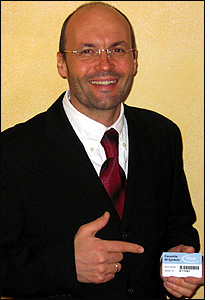Infineon Technologies, a producer of semiconductors, is using radio frequency identification combined with ultrasound-based location-tracking technology to continuously oversee and better manage its production of silicon wafers, which the company uses to make integrated circuits (ICs).
Headquartered in Munich, Germany, Infineon is using a system called LotTrack, created by Switzerland-based Intellion. LotTrack features battery-powered RFID devices called DisTags, which Infineon has affixed to containers, or lot boxes, of wafers to track each lot’s location. DisTags also feature no-power (bistable) display screens, which are automatically updated to provide instructions to employees working on the production lines. The DisTag battery can last for two years, according to Markus Dierkes, Intellion’s CEO.
DisTag contains a UHF (868 or 916 MHz) active RFID tag made by Identec Solutions that constantly communicates (via a proprietary protocol) with Intellion-designed, ceiling-mounted antennas. Equipped with an ultrasound sensor, the DisTag periodically receives signals sent by ultrasound emitters, also installed on the ceiling. The tag calculates the time-of-flight for the ultrasound signals it receives, storing these values in its memory. RFID interrogators read this data from the tag and transfer it to a server that calculates the location of the lot to within 0.5 meters.
At the start of production, an operator clips a DisTag to a lot box, which is labeled with an Infineon 13.56 MHz ISO 156693 passive tag encoded with a unique ID number. The worker then uses an Intellion-designed handheld 13.56 MHz RFID reader to positively identify that the correct lot box is being processed. In a second, separate RFID application installed by Infineon, RFID antennas on production machines read the passive MHz ISO 156693 RFID tag sewn into the wristband of the operator’s clean-room suits as the worker approaches a machine. When the machine positively identifies the worker, it displays a confirmation. As the system moves the lot box of wafers down the production line and tracks its movements, the LotTrack server updates the DisTag display with instructions corresponding to the lot box’s location.
A third RFID application, also part of Infineon’s “integrated fab” (iFAB) concept—fab being short for the German word Fabrik, which means ‘factory’—identifies wafer cassettes inserted into the machines. In the cassette ID system, also installed by Infineon without the help of Intellion, antennas on each piece of production equipment identify cassettes and confirm that the right process is being performed on the right lot. This system, in a sense, double-checks that workers have placed the right lot box on the right machine, as instructed on the DisTag. Before Infineon installed these antenna readers, this confirmation process was done manually.
Semiconductor production is a complex process that can include up to 500 steps per wafer lot on hundreds of different pieces of production machinery. Some semiconductor factories are fully automated (see Ultimate Control: RFID-Enabled Manufacturing). Infineon’s process, however, still includes such manual tasks as the transport of lot boxes among production bays. By automatically tracking each lot box, the system provides Infineon with a more comprehensive overview of production and capacity, while helping it track those machines that are free and those that are still in use. This allows the company to more effectively react to rush orders and other unexpected events. In addition, processing errors are reduced, thanks to the step-by-step instructions now available to workers on the DisTag displays. Before the LotTrack system was implemented, production instructions and tracking were accomplished using pen and paper.
Ultrasound technology provides a more accurate and stable system for tracking the lot boxes than RFID alone, particularly because Infineon’s production environment contains a lot of metal, which can interfere with an RFID tags’ radio waves. “By adding ultrasonic time-of-flight measuring, the system provides very accurate and robust location information,” says Dierkes.
Infineon had to work closely with Intellion to ensure the LotTrack system didn’t impact the clean room—the sterile environment necessary to produce semiconductors, says Hanspeter Fischer, a principal for computer integrated manufacturing at Infineon. “Antennas had to be adapted to the clean room,” he explains. “The air flow is important since particles of dust can harm a semiconductor.”
The company uses several thousand DisTags in three different LotTrack implementations. The system was installed at Infineon’s factory in Villach, Austria, in early 2004; its plant in Regensburg, Germany, in late 2004; and its Kulim, Malaysia, factory in 2006.
Fischer says the company received a return on its investment in the RFID applications within about one year of implementing them. He has declined to provide details at this time, but says Infineon is considering implementing another RFID application: using the tags already sewn into the operators’ suits to track their cleaning process.


